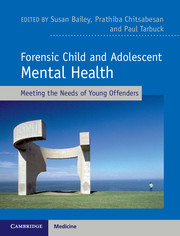Book contents
- Forensic Child and Adolescent Mental Health
- Forensic Child and Adolescent Mental Health
- Copyright page
- Dedication
- Contents
- Contributors
- Foreword
- Preface
- Prologue
- Section 1 Developmental Pathways
- Section 2 Assessment and Needs of Young Offenders
- Section 3 Serious Offences: Origins, Nature and Treatment
- Section 4 Assessment and Management
- Section 5 Therapeutic Approaches
- Chapter 17 Early Interventions in Conduct Disorder and Oppositional Defiant Disorder
- Chapter 18 Cognitive, Behavioural and Related Approaches in Young Offenders
- Chapter 19 Systemic Treatment Approaches in Young People with Risky Behaviours
- Chapter 20 Sounding the Picture – Drawing Out the Sound
- Section 6 Legal Frameworks, Organisations and Systems
- Epilogue
- Index
- References
Chapter 19 - Systemic Treatment Approaches in Young People with Risky Behaviours
from Section 5 - Therapeutic Approaches
Published online by Cambridge University Press: 04 May 2017
- Forensic Child and Adolescent Mental Health
- Forensic Child and Adolescent Mental Health
- Copyright page
- Dedication
- Contents
- Contributors
- Foreword
- Preface
- Prologue
- Section 1 Developmental Pathways
- Section 2 Assessment and Needs of Young Offenders
- Section 3 Serious Offences: Origins, Nature and Treatment
- Section 4 Assessment and Management
- Section 5 Therapeutic Approaches
- Chapter 17 Early Interventions in Conduct Disorder and Oppositional Defiant Disorder
- Chapter 18 Cognitive, Behavioural and Related Approaches in Young Offenders
- Chapter 19 Systemic Treatment Approaches in Young People with Risky Behaviours
- Chapter 20 Sounding the Picture – Drawing Out the Sound
- Section 6 Legal Frameworks, Organisations and Systems
- Epilogue
- Index
- References
- Type
- Chapter
- Information
- Forensic Child and Adolescent Mental HealthMeeting the Needs of Young Offenders, pp. 266 - 277Publisher: Cambridge University PressPrint publication year: 2017

